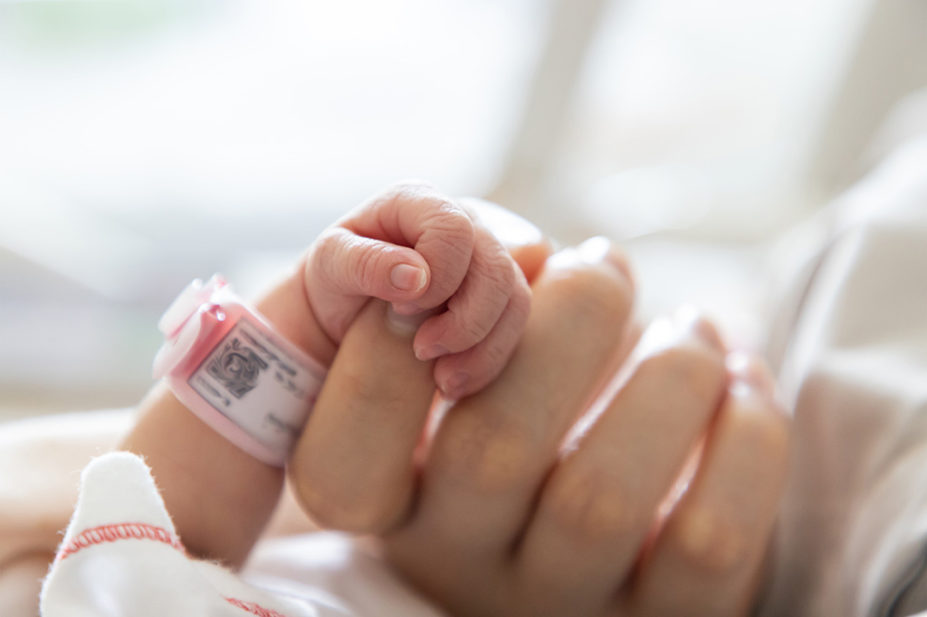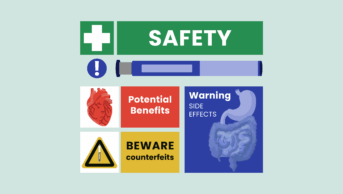
Shutterstock.com
It has been more than two years since the Independent Medicines and Medical Devices Safety Review’s (IMMDSR) report, ‘First do no harm’, exploring the harm caused by sodium valproate and other medicines and medical devices, was published[1].
But, still, three babies per month are being born after exposure to the antiepileptic.
This puts them at risk of foetal valproate spectrum disorder (FVSD); the collective name for the variety of disorders and development issues some children experience after being exposed to sodium valproate in the womb[2]. These include spina bifida, autism and malformations of the brain, heart, and kidneys, and in the most severe cases are linked with fatalities.
The devastating issue of sodium valproate has been described by Henrietta Hughes, the patient safety commissioner, as “a far bigger scandal than thalidomide” and, since her appointment in 2022, she has continued to urge the government to “not kick this issue into the long grass”.
Some progress has been made to act on recommendations laid out in the IMMDSR’s ‘First do no harm’ report — including the appointment of a patient safety commissioner and setting up a registry to monitor the effectiveness of the pregnancy prevention programme (PPP)[1].
And yet, thousands of women who could become pregnant are still taking sodium valproate. And there are now concerns about whether the effect of the drug could be transgenerational, and if male fertility could be adversely impacted too.
Slow progress
In 2018, NHS England set itself a target to reduce the use of valproate in people who can get pregnant by 50% by 2023, and to help prevent unplanned pregnancies in this group of patients.
However, analysis of data from the Medicines and Pregnancy Registry carried out by The Pharmaceutical Journal in January 2023 shows that there is still a long way to go[3].
So far, the number of people who can become pregnant (including women, transgender men and nonbinary people up to 54 years of age) who are taking sodium valproate has decreased by 28%, from 27,411 people in April 2018 to 19,766 people in March 2022 (see graph). For NHS England to meet its target, this figure would need to be reduced by almost the same percentage again by the end of 2023 (to 13,705 people).
New measures announced by the Medicines and Healthcare products Regulatory Agency (MHRA) in December 2022 promised “greater scrutiny” of the way sodium valproate is prescribed over the coming months[4].
Following a safety review carried out by the Commission on Human Medicines (CHM), it advised that no patient aged under 55 years should be initiated on the drug unless two specialists have independently considered and documented that there is no other effective or tolerated treatment.
A spokesperson for the NHS told The Pharmaceutical Journal that the new rules would make a “further significant contribution” to reducing use of the drug in women and girls who could get pregnant.
The CHM has established a sodium valproate expert working group to support the safe introduction of the new measures into clinical practice over the coming months, but patient groups have questioned how this might work in practice.
At a time when the NHS is under more pressure than ever, we are concerned about the challenges people with epilepsy will face in getting opinions from two different clinicians
Alison Fuller, director of health improvement and influencing at Epilepsy Action
“At a time when the NHS is under more pressure than ever, we are concerned about the challenges people with epilepsy will face in getting opinions from two different clinicians, particularly if valproate is the only effective drug in managing their seizures,” says Alison Fuller, director of health improvement and influencing at charity Epilepsy Action.
Fuller says that she is “concerned” that the new guidelines have come without adequate consultation from people with epilepsy, as well as about how they will impact on people’s treatment.
These concerns were reflected in minutes from a meeting of the NHS England’s Valproate Safety Implementation Group (VSIG) held in November 2021, obtained by The Pharmaceutical Journal via a Freedom of Information (FOI) request, in which it was acknowledged that two-clinician sign-off at point of initiation “may have a negative impact on patients”, likely owing to the challenge associated with coordinating two different clinicians to sign off the medication of every patient.
Widespread harm
The issues with sodium valproate do not end with people who can become pregnant and their babies. The MHRA has also highlighted that there are emerging risks to male sperm from valproate, as well as fertility issues that “can be reversed once the drug is stopped”. These risks, it said, could affect 100,000 males taking sodium valproate.
In addition, further reviews carried out by the MHRA have revealed some evidence that effects on behaviour, such as autism and developmental delay, linked with valproate could be passed on through more than one generation[5].
The two studies it considered, published in 2016 and 2018, investigated the effects in animals, and the MHRA confirmed that information on these are included in the product information for valproate-containing medicines.
Currently, we do not know what this means for human patients as it’s not always possible to be sure that an effect seen in animals will be the same in a person taking a medicine
Spokesperson for the Medicines and Healthcare products Regulatory Agency
“Currently, we do not know what this means for human patients as it’s not always possible to be sure that an effect seen in animals will be the same in a person taking a medicine,” a spokesperson for the MHRA told The Pharmaceutical Journal.
“Further human studies on this are ongoing.”
A report from the Health and Social Care Committee published in January 2023, which follows up on the government’s response to the IMMDS report, suggests that some families affected by FVSD are seeing second-generation problems. With some parents, who had been exposed before they were born, seeing their own children affected by similar issues[2,6].
“In a letter sent to us following the session, Dame June Raine [chief executive of the MHRA] stated that there is data suggesting that people affected by sodium valproate exposure as an unborn baby could potentially pass on effects to their children,” the committee report suggested.
“Dame June also pointed to European-commissioned studies into transgenerational effects of sodium valproate which following a delay due to COVID-19, is expected to publish results by the end of 2023.”
The committee said it was “concerned that data on reports of transgenerational effects had not been collected in the UK” and that it “cannot understand” how it was “not in the interest” of the government to monitor transgenerational effects in those affected in the UK.
Epilepsy control
Much of the challenge around sodium valproate comes from the fact that the drug can present the only treatment option for some patients, and the MHRA is clear that no one should stop taking it without advice from their healthcare professional.
“It remains the case that, for some people with epilepsy, this medication is the only one that works to control their seizures,” says Daniel Jennings, senior policy & campaigns officer at Epilepsy Action.
In some cases, stopping sodium valproate can bring its own set of dangers.
Minutes from a meeting of the VSIG held on January 2021, obtained via FOI request, revealed that sudden unexpected death in epilepsy was a “potential harm of deprescribing” sodium valproate and something that the group were currently considering monitoring.
We need to see more research into new treatments for epilepsy to give people currently taking sodium valproate more viable and safe alternatives
Daniel Jennings, senior policy & campaigns officer at Epilepsy Action
“We need to see more research into new treatments for epilepsy to give people currently taking sodium valproate more viable and safe alternatives to this and other epilepsy medicines currently available,” says Jennings.
“Until we have these alternatives, there will be people with epilepsy for whom sodium valproate is the only medicine that effectively controls their seizures.”
But valproate isn’t the only antiepileptic causing concern.
In 2021, an MHRA safety review found that carbamazepine, phenobarbital, phenytoin and topiramate were all associated with an increased risk of major congenital malformations[7].
A further MHRA review, in July 2022, looking specifically at the safety of topiramate, concluded that topiramate was not a safe alternative to sodium valproate; in fact, it found it was linked to a similar level of risk[8].
And while prescribing of valproate during pregnancy has been reducing, albeit more slowly than hoped, prescribing of topiramate has increased by more than a third (see graph).
In July 2022, the MHRA launched a safety review to look at prescribing of topiramate in more detail. The Pharmaceutical Journal tried to find out when the outcome of this would be published, but the MHRA said they were unable to confirm timings “at this point”.
There are other safety measures yet to be announced.
Currently, if a GP prescribes the standard multiples of 28 tablets for sodium valproate, while standard pack sizes are 30, 100 and 112, legislation states that pharmacists have to split the pack and use a plain white box[9]. This means the medicine may be supplied in the absence of the patient information leaflet (PIL) and warnings about pregnancy that come with the original packaging.
This might change, but it has been more than a year since the Department of Health and Social Care consulted on proposals to update the legislative requirements to enable original pack dispensing for pharmacists and to ensure medicines that contain sodium valproate are always dispensed in the original manufacturer’s packaging, including the PIL and relevant warnings[10].
In December 2022, the government said it had “considered” the responses received and would “shortly publish a response” with a decision about the proposed amendment to the Human Medicines Regulations 2012[11].
The delay, according to the patient safety commissioner’s 100-day report, is the result of “political upheaval” and Hughes has vowed to “work with partners across health to eliminate dispensing of sodium valproate in unlabelled white boxes”[9,12].
Pharmacy is part of the solution
As part of a PPP, pharmacists are required to: remind patients of the risks of taking sodium valproate in pregnancy and the need for highly effective contraception; ensure patients have been given the patient guide; and remind patients of the need for an annual specialist review.
However, a report on the 2019/2020 Pharmacy Quality Scheme Valproate Audit — which was carried out in community pharmacies across England — published on 11 August 2022, found that pharmacists were not referring or signposting “a sizeable minority” of people, who appeared to be without appropriate contraception, back to the prescriber[13,14].
Recognising this as an area to address, in November 2022, the Pharmaceutical Services Negotiating Committee (PSNC) and NHS England announced that they had agreed that the 2022/2023 national clinical audit would focus on valproate, with the aim of reducing the potential harm caused by taking valproate during pregnancy[15].
In addition, the ongoing NHS Community Pharmacy Contraception Service pilot could play a role in highlighting the importance of effective contraception for patients taking sodium valproate and other antiepileptics.
In VSIG meeting minutes from November 2021, obtained via a FOI request, attendees discussed the pilot having “added benefits” regarding co-dispensing of sodium valproate and contraception, highlighting that there is a “high dropout rate” between prescribing and dispensing of contraception.
“[The pilot] adds another helpful touch point to talk to patients about their medication and contraception”, the minutes read.
Overall, while some progress has been made to reduce the use of sodium valproate in people who can become pregnant, this is just the tip of a much larger iceberg. There is an urgent need to collect data about the impact of the drug on male fertility, as well as the potential transgenerational effects that may be starting to emerge to be able to get a true idea of how serious these issues are.
This is not something that can be sat on; for the sake of families across the UK, this is an issue that needs to be addressed now.
Box: What needs to be done?
Janet Williams and Emma Murphy, founders of the Independent Foetal Anti-Convulsant Trust
“We hope that healthcare professionals prescribing valproate to women ensure their patients all receive the Pregnancy Prevention Program (PPP) and follow it to the letter.
“So many women have been failed by a system which failed in itself to be rigorous enough.
“It is important to bear in mind there is around 200 babies still harmed each year, which all adds to the cost of the public purse — which can be avoided by healthcare professionals playing their part in the uptake of the PPP.”
Henrietta Hughes, patient safety commissioner
“I am very disappointed that thousands of patients are still taking sodium valproate while at risk of pregnancy. The target to halve the number set by NHS England is unlikely to be met and patients are not always informed of the harm that can occur.
“Three babies a month are still being born after exposure to sodium valproate. This is a far bigger scandal than thalidomide. The government urgently needs to listen to patients, commit to financial redress for families who have suffered and not kick this issue into the long grass.”
Daniel Jennings, senior policy & campaigns officer, Epilepsy Action
“NHS England should seek to ensure that all people with epilepsy are aware of the risks of taking sodium valproate so they can make an informed choice about their treatment.
“Unfortunately, despite the efforts of NHS England, MHRA and others overrecent years, we are aware that there are some people who remain unaware of these risks.”
- 1First Do No Harm: The report of the Independent Medicines and Medical Devices Safety Review . Independent Medicines and Medical Devices Safety Review . 2020.https://www.immdsreview.org.uk/downloads/IMMDSReview_Web.pdf (accessed 9 Feb 2023).
- 2Follow-up on the IMMDS report and the Government’s response; Sixth Report of Session 2022–23. House of Commons Health and Social Care Committee . 2023.https://committees.parliament.uk/publications/33601/documents/183831/default/ (accessed 9 Feb 2023).
- 3‘Urgent’ action required to reduce level of harm from valproate, says patient safety tsar. Pharmaceutical Journal. 2023. doi:10.1211/pj.2023.1.171312
- 4Healthcare professionals to be ‘better monitored’ on new valproate safety measures. Pharmaceutical Journal. 2022. doi:10.1211/pj.2022.1.169836
- 5Valproate: reminder of current Pregnancy Prevention Programme requirements; information on new safety measures to be introduced in the coming months. GOV.UK. 2022.https://www.gov.uk/drug-safety-update/valproate-reminder-of-current-pregnancy-prevention-programme-requirements-information-on-new-safety-measures-to-be-introduced-in-the-coming-months#chm-advice-and-recommended-new-measures (accessed 9 Feb 2023).
- 6MHRA to consider evidence on transgenerational effects of sodium valproate. Pharmaceutical Journal. 2022. doi:10.1211/pj.2022.1.148102
- 7Some antiseizure duotherapies associated with similar risk of neurodevelopmental disorders as valproate, study finds. Pharmaceutical Journal. 2022. doi:10.1211/pj.2022.1.144911
- 8Safety review launched into anti-epileptic medicine topiramate over fears of harm to unborn children. Pharmaceutical Journal. 2022. doi:10.1211/pj.2022.1.151312
- 9Patient Safety Commissioner 100 Days Report. The Patients Association. 2023.https://www.patients-association.org.uk/Handlers/Download.ashx?IDMF=abf20ccc-cc86-4ee6-a9fc-38c58af50424 (accessed 9 Feb 2023).
- 10Original pack dispensing and supply of medicines containing sodium valproate. Department of Health and Social Care. 2021.https://www.gov.uk/government/consultations/original-pack-dispensing-and-supply-of-medicines-containing-sodium-valproate (accessed 9 Feb 2023).
- 11Independent Medicines and Medical Devices Safety Review: update report on government implementation. Department of Health and Social Care. 2022.https://www.gov.uk/government/publications/independent-medicines-and-medical-devices-safety-review-update-report-on-government-implementation/independent-medicines-and-medical-devices-safety-review-update-report-on-government-implementation#sodium-valproate (accessed 9 Feb 2023).
- 12Patient safety tsar to ‘eliminate’ dispensing of sodium valproate in white boxes. Pharmaceutical Journal. 2023. doi:10.1211/pj.2023.1.173998
- 13Community Pharmacy Quality Scheme 2019/20 Valproate Audit Report. NHS England . 2022.https://www.england.nhs.uk/wp-content/uploads/2022/07/B1504_Community-Pharmacy-Quality-Scheme-2019-20-valproate-audit-report-July-2022.pdf (accessed 9 Feb 2023).
- 14Safety requirements for use of valproate ‘still not being fully met’, finds NHS audit. Pharmaceutical Journal. 2022. doi:10.1211/pj.2022.1.153368
- 15Mandatory national audit announced. Pharmaceutical Services Negotiating Committee. 2022.https://psnc.org.uk/our-news/mandatory-national-audit-announced/ (accessed 9 Feb 2023).
2 comments
You must be logged in to post a comment.



It's easier to collect the data on how many women of childbearing age are being prescribed valproate, but not so easy to draw the conclusion that they are not being informed about the risks. The only way to gain this level of insight is through clinical audit.
Also with regard to women on valproate who have given birth, is there clinical audit to show whether they were informed about the risks or not before conceiving? How about those patients that choose not to complete the prevent form? I appreciate that more can be done, but need to be careful about assuming it is always due to a failure of healthcare professionals re informing the patient.
Interesting that their working party includes no pharmacists. That may be a problem. And also their insistence of calling it sodium valproate throughout and not including the names valproic acid and semisodium valproate, which may confuse some people (service users and maybe one or two healthcare professionals and carers) and lead them not to make the connection.